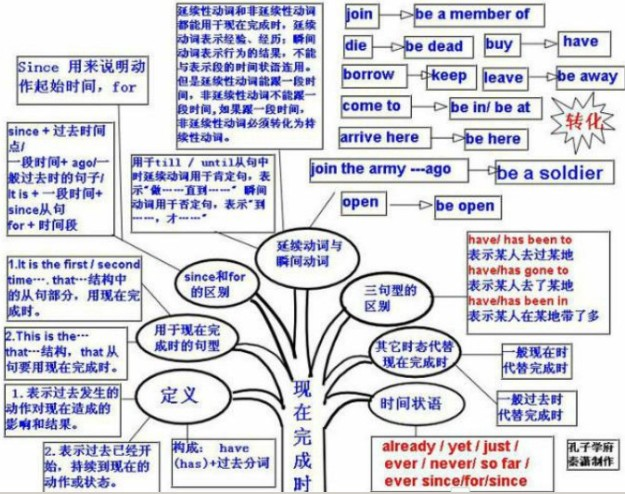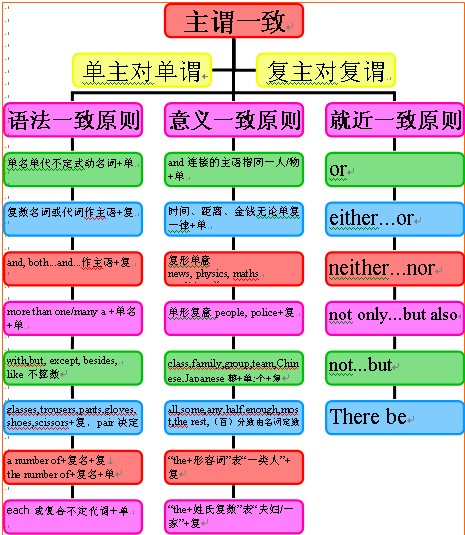本试题 “用所给动词的适当形式填空1. He _____(learn) English for 8 years.2.I'm so tired, I ____ ( drive) for eight hours without a rest.3. You _____ ( do) th...” 主要考查您对一般过去时
现在完成时
过去完成时
现在完成进行时
将来完成时
主谓一致
等考点的理解。关于这些考点您可以点击下面的选项卡查看详细档案。
- 一般过去时
- 现在完成时
- 过去完成时
- 现在完成进行时
- 将来完成时
- 主谓一致
一般过去时的概念:
一般过去时表示过去某个时间里发生的动作或状态;过去习惯性、经常性的动作、行为;过去主语所具备的能力和性格。
一般过去时的用法:
1、表示过去发生的动作或存在的状态,常与表示过去时间的副词如:yesterday,last week,two hours ago等连用。
如:My family moved here five years ago. 我家五年前搬到了这里。
I was born in 1973. 我生于1973年。
2、表示过去一段时间经常或反复发生的动作。这时可与频度副词如:often,usually,always等连用。
如:He always worked in tonight those days. 那些日子他总是工作到深夜。
I often left on business in 1987. 1987年我经常出差。
注:表示“过去经常,而今不再”时,要用usedto.
如:I used to read newspaper after breakfast. 我过去经常早饭后看报纸。(意指现在已不是这样)
The children often swam in this river. 孩子们过去经常在这条河里游泳。
3、表示过去发生的一连串动作。
如:He put down the heavy box, took out the keys, and opened the door. 他放下这沉重的箱子,掏出钥匙开了房门。
注:过去发生的一连串动作,若用and,or,but等并列连词连接,则一律用过去式。
如:They moved the chairs to the table, sat down and began to have supper. 他们把椅子搬到桌边,坐下开始吃饭。
4、在时间和条件状语从句中,用一般过去时表示过去将来的动作。
如:He said that he would let me know as soon as he got the information. 他说他一得到消息就立即让我知道。
Mary told me that she would stay at home if it rained. 玛丽告诉我如果下雨她就呆在家里。
一般过去时的特别用法:
1、句型:It is time for sb. to do sth "到……时间了" "该……了"。
例如:It is time for you to go to bed.你该睡觉了。
It is time that sb.did sth. "时间已迟了" "早该……了"。
例如:It is time you went to bed. 你早该睡觉了。
2、would(had)rather sb.did sth. 表示'宁愿某人做某事'。
例如:I'd rather you came tomorrow. 还是明天来吧。
3、wish, wonder, think, hope等用过去时,作试探性的询问、请求、建议等,而一般过去时表示的动作或状态都已成为过去,现已不复存在。
例如:I thought you might have some. 我以为你想要一些。
比较:Christine was an invalid all her life.(含义:她已不在人间。)
Christine has been an invalid all her life.(含义:她现在还活着)
Mrs. Darby lived in Kentucky for seven years.(含义:达比太太已不再住在肯塔基州。)
Mrs. Darby has lived in Kentucky for seven years.(含义:现在还住在肯塔基州,有可能指刚离去)
注意:用过去时表示现在,表示委婉语气。
1)动词want, hope, wonder, think, intend等。
例如:Did you want any thing else? 您还要些什么吗?
I wondered if you could help me. 能不能帮我一下。
2)情态动词could, would。
例如:Could you lend me your bike? 你的自行车,能借用一些吗?
现在完成时的概念:
现在完成时用来表示之前已发生或完成的动作或状态,其结果的影响现在还存在;也可表示持续到现在的动作或状态。其构成:have(has)+过去分词。
现在完成时共有四种主要用法:
一、现在完成时表示影响:
该用法的现在完成时表示一个过去发生的动作在过去已经完成,并且这个过去发生并完成的动作对现在有影响或结果,同时说话者强调的或感兴趣的就是这个影响或结果,如汉语说“他已离开这个城市了”,其中的“离开”肯定发生了,它对现在的影响或结果就是“他现在已不在这个城市了”;又如汉语说“有人把窗户打破了”,显然“打破窗户”这一动作发生在过去,并且在过去已经完成了,但说话人强调的重点是打破窗户对现在的影响—窗户现在仍是破的。
如:He has left the city. 他已离开这个城市。(结果:他不在这个城市。)
Someone has broken the window. 有人把窗户打破了。(结果:窗户仍破着。)
I have lost my pen. 我把钢笔丢了。(结果:我现在无钢笔用。)
He has finished his work. 他把工作做完了。(结果:他现在可以做其他的事了。)
二、现在完成时表示持续:
该用法的现在完成时表示一个过去发生的动作或开始的状语在过去并未完成或结束,而是一直持续到现在,并且有可能继续下去(也可能到此结束),如汉语说“他在我们学校教书已有30年了”,显然“他在我们学校教书”是从30年前开始,并且一直教到现在,已经持续了30年;又如汉语说“自上个星期以来他一直很忙”,显然“忙”是从上个星期开始的,并且这一“忙”就一直忙到现在。
如:He has taught in our school for 30years. 他在我们学校教书已有30年了。
He has been busy since last week. 自上个星期以来他一直很忙。
He has worked for us ever since he left school. 他离开学校以后就一直为我们工作。
三、现在完成时表示重复:
即表示从过去某个时间直到现在的这个时间范围内不断重复发生的动作或情况,并且这个不断重复的动作有可能继续下去,也有可能到现在就结束。
如:How often have you seen her? 你隔多少见她一次?
My father has always gone to work by bike. 我父亲一向骑车上班。
四、现在完成时表示将来:
同一般现在时可以表示将来一样,现在完成时也可以在时间状语从句里表示将来。
如:I'll wait until he has written his letter. 我愿等到他把信写完。
When you have rested, I'll show you the garden. 等你休息好之后,我领你看我们的花园。
现在完成时知识体系:

比较一般过去时与现在完成时:
1)一般过去时表示过去某时发生的动作或单纯叙述过去的事情,强调动作;现在完成时为过去发生的,强调过去的事情对现在的影响,强调的是影响。
2)一般过去时常与具体的时间状语连用,而现在完成时通常与模糊的时间状语连用,或无时间状语。一般过去时的时间状语:yesterday, last week,…ago, in1980, in October, just now等,皆为具体的时间状语。现在完成时的时间状语:for, since, sofar, ever, never, just, yet, till/until, up to now, in past years,always等,皆不确定的时间状语。共同的时间状语:this morning, tonight, this April, now, already, recently, lately等。
3)现在完成时可表示持续到现在的动作或状态,动词一般是延续性的,如live, teach, learn, work, study, know。一般过去时常用的非持续性动词有come, go, leave, start, die, finish, become, get married等。
例如:I saw this film yesterday.(强调看的动作发生过了)
I have seen this film.(强调对现在的影响,电影的内容已经知道了)
Why did you get up so early?(强调起床的动作已发生过了)
Who hasn't handed in his paper?(强调有卷子未交,疑为不公平竞争)
He has been in the League for three years.(在团内的状态可延续)
He has been a League member for three years.(是团员的状态可持续)
句子中如有过去时的时间副词(如yesterday, last, week, in1960)时,不能使用现在完成时,要用过去时。
(错)Tom has written a letter to his parents last night.
(对)Tom wrote a letter to his parents last night.
过去完成时的概念:
过去完成时既可表示过去某个时间或动作之前所发生的事情,也可表示过去某个时间或动作之 前所发生的动作一直持续到过去某个时间。过去完成时由“had+过去分词”构成。
如:She had leant 2000 English words by the end of last month.
过去完成时的应用:
(1)与过去完成时连用的时间状语可以多种多样,使用它的主要依据是看其是否发生在“过去的过去”。
如:He had learnt some English before I went here. 在来这儿之前我学过一些英语。
He had written three stories by last year.到去年他已经写了三篇故事。
We had cleaned the room when he got there. 当他到那儿时,我们已经把房子弄干净了。
He went there after he had finished his work. 他把事做完之后,就去哪儿了。
注意:当主句跟由before, after, as soon as所引导的时间从句的动作连接很紧密时,从句也可用一般过去时。
如:He went there after he read the letter. 他看了那封信后就去那儿了。
(2)过去完成时还经常用于主句为过去时的宾语从句中。
如:He said he had been a soldier. 他说他当过兵。
They said they had seen the film. 他们说这幕电影他们看过。
(3)在hardly/scarcely…when…,nosooner…than…两个结构中的主句通常要用过去完成时。
如:Hardly had I told her the news when she began to cry out. 她一听到这一消息就大哭了起来。
Scarcely had he finished his supper when he went out. 他已吃完晚饭就出去了。
No sooner had he fallen asleep than he lay down on the bed. 他一躺倒床上就睡着了。
(4)动词expect, hope, suppose, think, want等的过去完成时可用来表示未实现的计划、打算或希望。
如:I had hoped to see you. 我本希望来看你。
He had wanted to buy a house in Beijing. 他本想在北京买栋房子。
过去完成时与一般过去时:
(1)过去完成时表示以过去某时间为起点以前所发生的动作或存在的状态,即:过去完成时强调“过去的过去”,而一般过去时只表示以现在时间为起点以前所发生的事情或存在的状态。
如:He studied there two years ago. 他在那儿学习了两年。(离现在两年)
He said he had studied there two years ago. 他说他在那儿学习了两年。(离他说话时两年)
(2)表示过去某个时间以前所连续发生的两个或两个以上的动作时,一般用and, then, but按照动作的先后顺序连接,此时通常用一般过去时而不用过去完成时。
如:He said he went the shop and bought some food. 他说他去商店买了一些食品。
(3)两个动作相继发生,可用一般过去时;如第一个动作需要若干时间完成,用过去完成时。
如:When I heard the news, I was very excited.
(4)叙述历史事实,可不用过去完成时,而只用一般过去时。
如:Our teacher told us that Columbus discovered America in1492.
现在完成进行时的概念:
现在完成进行时表示某动作从过去某个时间开始,一直延续到现在,并且还有可能持续下去。
如:We have been waiting for him for two hours. 我们等他等了两个小时。
现在完成进行时的结构:
现在完成进行时由“have/hasbeen+现在分词”构成。
现在完成进行的基本用法:
(1)表示现在以前这一段时间里一直在进行的动作,这动作可能仍在进行,也可能已停止。
如:It has been raining since last Sunday. 自上周星期日以来就一直在下雨。
He's been watching television all day. 他看了一天电视了。
(2)现在完成进行时有时表示根据直接或间接的证据得出的结论。
如:She is very tired. She's been typing letters all day. 她很累了,她整天都在打信件。
Her eyes are red. She has been crying. 她眼睛红了。她一直在哭。
现在完成进行时与现在完成时的区别:
1、现在完成时可以表示一个已经完成的动作,而现在完成进行时则表示一个正在进行的动作。
如:I have read the book. 我读过这本书。
I have been reading the book.我一直在读这本书。
【注】有少数动词(如work, study, live, teach, stay等)在表示持续一时间时用这两种时态含义差不多(只是用现在完成进行进更强调动作的持续性)。
如:How long have you worked [been working] here? 你在这儿工作多久了?
I've lived [been living] here since1988. 自1988年以来我就一直住在这儿。
2、现在完成时通常只陈述事实,而现在完成进行时还可表示一种感情色彩。
如:I have waited for two hours. 我等了两小时。(陈述事实)
I have been waiting for two hours. 我等了两个小时。(等得好辛苦)
3、现在完成进行时通常用来谈论较短暂的动作或情况,若要谈论时间延续较长的动作或情况或永久性情况,则通常用现在完成时。
如:He has lived in Paris. 他(一直)住在巴黎。
He has been living in Paris. 他(目前)住在巴黎。(表暂时性)
4、不用于进行时态的动词通常也不用于现在完成进行时,但它们可以用于现在完成时。
如:I've only known her for two day. 我认识她刚刚两天。
They've been married for twenty years. 他们结婚已二十年了。
The war has lasted for a long time. 这场战争持续了很长时间。
5、现在完成进行时不用于被动语态,若要用可用现在完成时的被动语态代替。
如:The house has been painted for a month. 这房子已漆了一个月。
The problem has been studied for five days. 这个问题已研究了五天。
将来完成时概念:
将来完成时用来表示在将来某一时间以前已经完成或一直持续的动作。经常与before+将来时间或by+将来时间连用,也可与before或by the time引导的现在时的从句连用。
将来完成时的构成与用法:
(一)构成:will/shall have+过去分词:
如:We hope it will have stopped raining before we set off for the picnic. 我们希望在出发去野餐以前雨就已经停了。
I'll have done all the work by the time you are back this evening. 你们今晚回来的时候我就将做完所有的工作了。
(二)用法:
1、表示在将来某一时刻将完成或在另一个未来的动作发生之前已经完成的动作。
注意:常与将来完成时连用的时间状语有:
①by(the time/the end of)+表示将来时间的短语和句子;
②before(the end of)+表示将来时间的词语或句子;
③when, after等加上表示将来动作的句子等。
例如:By the year 2050, scientists probably will have discovered a cure for cancer.
到2050年,科学家们可能已经找到治愈癌症的方法了。
By the time you arrive in London, we will have been staying in Europe for two weeks.
等你到达伦敦的时候,我们将已经在欧洲呆了两星期了。
2、在时间从句和条件从句中,现在完成时可以代替将来完成时,表示将来某时业已完成的动作。
例如:You'll get to like the subject after you have studied it for some time.
在学习这个学科一段时间之后,你就会喜欢它的。
I'll go and see the exhibition as soon as I have finished my work. 我一做完作业就去看展览。
3、将来完成时还可以表示"可能性",或"设想"。
例如:It's five o'clock, they will have arrived home by now. 已经五点钟了,他们现在应该已经到家了。
将来完成时与一般将来时的比较:
1、有具体的时间状语要用一般将来时。
如:Mr Smith will return home on the first Sunday next month. 史密斯先生将于下月的第一个星期日回家。
2、将来完成时的时间状语一般用介词by引入。
如:Mr Smith will have returned home by next month. 到下个月史密斯先生将已回到家了。
典例精析:
1、They_____on the program for almost one week before I joined them, and now we_____it as no good results have come out so far.
A. had been working; are still working
B. had worked; were still working
C. have been working; have worked
D. have worked; are still working
答案:A。
解析:不难看出第一空的动作发生在I joined them以前,且持续了一个周,应该用过去完成进行时;and now说明下面的动作仍在进行之中,应该用现在进行时。故选A。
2、Father_____for London on business up on my arrival, so I didn't see him.
A.has left
B.left
C.was leaving
D.had left
答案:D。
解析:由"I didn't see him"可知父亲在我回来以前已经离开,动作发生在过去某个动作以前,故选用过去完成时。
3、The policeman's attention was suddenly caught by a small box which_____placed under the Minister's car.
A. has been
B. had been
C. was being
D. would be
答案:B。
主谓一致的概念:
谓语的数必须和主语的人称和数保持一致,这就叫主谓一致。
主谓一致的基本原则:
1)语法一致原则,即在语法形式上取得一致。例如,主语是单数形式,谓语动词也采取单数形式;主语是复数形式,谓语动词也采取复数形式。
例如:The students are very young.
This picture looks beautiful.
2)意义一致原则,即从意义着眼处理一致关系。例如,主语形式虽是单数但意义是复数,谓语动词也采取复数形式;
而有些主语形式虽是复数但意义上看作单数,谓语动词也采取单数形式。
例如:The people in that country are fighting for independence.
The crowd deeply respect their leader.
Three years in a strange land seems a long time.
3)就近原则,即谓语动词的单数或复数形式取决于最靠近它的词语。
例如:Neither hen or I am going to see the film tonight because we are busy.
几对容易混淆词组的一致用法:
1、由“this/thatkind/typeof+名词”作主语,谓语动词用单数形式;而由"these/thosekind/typeof+复数名词”作主语,谓语动词用复数形式。
例如:This kind of apples is highly priced.
Those kind(s) of tests are good.
2、由“a number of,a totalo f,an average of+复数名词”作主语,谓语动词用复数形式;由“the number of,the total of,the average of+复数名词”作主语,谓语动词用单数形式。
例如:A number of students are waiting for the bus.
The number of the students in this university is increasing yearly.
3、one of,the(only) one of的一致用法
例如:This is one of the books that have been recommended.
This is the(only) one of the books that has been recommended.
主谓一致用法点拨:
1、并列结构作主语谓语用复数:
如:Reading and writing are very important.
注意:当主语由and连结时,如果它表示一个单一的概念,即指同一人或同一物时,谓语动词用单数,and此时连接的两个词前只有一个冠词。
如:The iron and steel industry is very important to our life.
典型例题:
The League secretary and monitor___asked to make a speech at the meeting.
A. is
B. was
C. are
D. were
答案:B.
注:先从时态上考虑。这是过去发生的事情应用过去时,先排除A、C本题易误选D,因为The League secretary and monitor 好象是两个人,但仔细辨别,monitor前没有the,在英语中,当一人兼数职时只在第一个职务前加定冠词。后面的职务用and相连。这样本题主语为一个人,所以应选B。
2、主谓一致中的靠近原则:
1)当there be句型的主语是一系列事物时,谓语应与最邻近的主语保持一致。
例如:There is a pen, a knife and several books on the desk.
There are twenty boy-students and twenty-three girl-students in the class.
2)当either…or…与neither…nor,连接两个主语时,谓语动词与最邻近的主语保持一致。
如果句子是由here, there引导,而主语又不止一个时,谓语通常也和最邻近的主语一致。
例如:Either you or she is to go.
Here is a pen, a few envelops and some paper for you.
3、谓语动词与前面的主语一致:
当主语后面跟有with, together with, like, except, but, no less than, as well as等词引起的短语时,谓语动词与前面的主语一致。
例如:The teacher together with some students is visiting the factory.
He as well as I wants to go boating.
4、谓语需用单数:
1)代词each和由every, some, no, any等构成的复合代词作主语,或主语中含有each,every,谓语需用单数。
例如:Each of us has a tape-recorder.
2)当主语是一本书或一条格言时,谓语动词常用单数。
例如:The Arabian Night is a book known to lovers of English.
3)表示金钱,时间,价格或度量衡的复合名词作主语时,通常把这些名词看作一个整体,谓语一般用单数。(用复数也可,意思不变。)
例如:Three weeks was allowed for making the necessary preparations.
Ten yuan is enough.
5、指代意义决定谓语的单复数:
1)在代词what, which, who, none, some, any, more, most, all等词的单复数由其指代的词的单复数决定。
例如:All is right. (一切顺利。)
All are present. (所有人都到齐了。)
2)集体名词作主语时,谓语的数要根据主语的意思来决定。
例如:family, audience, crew, crowd, class, company, committee等词后用复数形式时,意为这个集体中的各个成员,用单数时表示该个集体。
例如:His family isn't very large. 他家不是一个大家庭。
His family are music lovers. 他的家人都是音乐爱好者。
但集合名词people, police, cattle, poultry等在任何情况下都用复数形式。
例如:Are there any police around?
3)有些名词,如variety, number, population, proportion, majority等有时看作单数,有时看作复数。
A number of+名词复数+复数动词。 The number of+名词复数+单数动词。
例如:A number of books have lent out.
The majority of the students like English.
6、与后接名词或代词保持一致:
1)用half of, part of, most of, a portion of等词引起主语时,动词通常与of后面的名词,代词保持一致。
例如:Most of his money is spent on books.
Most of the students are taking an active part in sports.
2)在一些短语,如many a或more than one所修饰的词作主语时,谓语动词多用单数形式。
但由more than…of作主语时,动词应与其后的名词或代词保持一致。
例如:Many a person has read the novel. 许多人都读过这本书。
More than 60percent of the students are from the city. 百分之六十多的学生都来自这个城市
主谓一致知识体系:

主谓一致用法拓展:
1)当everyone,everybody,noone,nobody,anyone,anybody,someone,somebody,everything,anything,something,nothing等用作主语时,其相应的代词一般用单数形式。
例如:If anybody calls, tell him that I'm out.
Something strange happened, didn't it?
2)人称代词与名词的呼应:人称代词I(me),he(him),she(her),it(it) 都是代替前面的单数名词,而they(them),we(us)则是代替复数名词的,you既可以代表单数,也可以代表复数。但表示泛指的时候,用he或one来表示。
例如:If a young person enters a classical music field only for money, he is in the wrong profession.
3)物主代词与名词的呼应:my,our,his,her,its,their要与代替的名词在数上一致。
例如:The welfare department,as well as the other social services,will have its budget cut.
4)反身代词与其所代成分间的呼应。
例如:Many primitive people believed that by eating ananimal they could get some of the good qualities of that animal for themselves.
5)指示代词与所代名词间的呼应:this和that指代单数名词或不可数名词,these和those指代复数名词(those还可以用作先行词,引导定语从句,表示“那些人”)。
例如:She invited all those who had been her former colleagues.
6)much和muchof后接不可数名词,而many和manyof后接可数名词的复数。
例如:There is not much coal left.
A great many of the houses were knocked down by the earthquake.
7)表示量的词后面有的接可数名词,有的接不可数名词。
接可数名词的有:a number of,a rangeof,a series of十复数名词;
接不可数名词的有:a great deal of,an amount of十不可数名词;
既可接可数又可接不可数名词的有:a lot of,a variety of。
例如:1.The government attached a great deal of importance to education.
2.Quiteanumberofwomenappliedforthisjob.
3.The college library has avariety of books.
4.An apple is avariety off ruit.
与“用所给动词的适当形式填空1. He _____(learn) English for 8 ...”考查相似的试题有:
- 短文改错文中共有10处语言错误,每句中最多有两处.错误涉及一个单词的增加、删除或修改增加:在缺词处加一个漏字符号(∧),并在其...
- — Ann is in hospital.— Oh, really? I _____ know. I _____ go and visit her.[ ]A. didn't; am going toB. don't; wouldC. ...
- — Where do you think ___ he ___ the computer?— Sorry, I have no idea.[ ]A. has; boughtB. /; boughtC. did; buyD. had; ...
- — I wonder how long you _____ in Beijing.— Just for the weekend, then I had to attend a conference in Tianjin.A. will...
- 短文改错。 I went shopping with my wife. We have a lot of things to buy them. We drove to the center of the city and ...
- By the time he arrived in Beijing, we _____ there for two days.A. will have stayedB. stayC. have been stayingD. had s...
- 短文改错。该短文中共有10处错误,每句中最多有两处,错误涉及一个单词的增加、删除或修改。增加:在缺词处加一个漏字符号(^)...
- —Does the old man know the museum very well?—No, this is the first time he __________ here.A.wasB.cameC.has beenD...
- It is reported that many a new house _____ at present in the disaster area.A. are being builtB. were being builtC. wa...
- Very few his address in the town. A.knowsB.knowC.are knowingD.has known